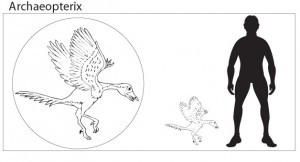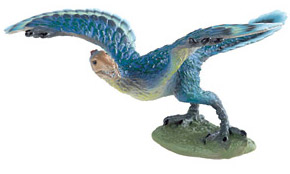Natural History Museum is Getting the Bird
“London” Specimen of Archaeopteryx is the Type Specimen
Perhaps one of the most famous fossils ever found, the beautifully preserved and almost complete fossil of Archaeopteryx that was discovered in 1861 and later purchased by Sir Richard Owen for what was to become the Natural History Museum (London) has been declared the type specimen. Experts at the International Commission on Zoological Nomenclature (ICZN) have ruled that this fossil, known as the “London” specimen after Sir Richard bought it for £700, has been declared the official representative of the Archaeopteryx species (A. lithographica).
Specimen of Archaeopteryx
Archaeopteryx, this tantalising mixture of bird and reptile was named and described by the German palaeontologist Hermann von Meyer in 1861. The first fossil evidence of Archaeopteryx that came to the attention of science was a single, fossilised feather that had been preserved in the fine-grained limestone deposits at Solhofen (Germany).
A Scale Drawing of Archaeopteryx
Picture credit: Everything Dinosaur
Please note, yes we know we have the name spelt wrong in the title above the drawing and our Archaeopteryx does remind us of a duck because of its “bill”, but we did what we could to give the artist a steer on the drawing – whether he listened to us, that’s a different matter.
The “London” Specimen
The “London” specimen was found just two years after Charles Darwin had published his ground-breaking theory on natural selection, and here was a transitional fossil showing a mix of bird and reptilian features – adding weight to Darwin’s conclusions. The ICZN has ended five years of debate and discussion and now ruled that the “London” specimen should be the type specimen for this species – the specimen that scientists use to provide a scientific description of the characteristics of a species, a sort of blueprint to which all other Archaeopteryx fossils found have to be compared with.
The ICZN is the body responsible for regulating the naming of all extinct and extant species. They help to ensure that names are used universally and they settle disputes over naming and the classification of organisms.
A spokesperson for Everything Dinosaur could not help using a pun when asked to comment on this ruling, he stated:
“The specimen held at the Natural History Museum [London] is a fantastically well-preserved fossil and provides researchers with the opportunity to study this 147-million-year-old creature in great detail. The Natural History Museum based scientists and other researchers have already produced some amazing information and data on the bird/dinosaur link as well as the evolution of birds. Having it declared the type specimen is a real feather in their cap.”
However, for every scientist that applauds this decision there will be others who contest it. A number of palaeontologists and taxonomists felt that a change in the type specimen was unjustified. The previous type specimen – that single feather referred to earlier, is now thought to belong to another fossil bird species discovered at Solnhofen and it may not relate to A. lithographica at all.
A Model of Archaeopteryx
Picture credit: Everything Dinosaur
Commenting on the change, one that will see the debate amongst palaeontologists continue no doubt, Dr Ellinor Michel, the Executive Secretary of the ICZN stated:
“Changing type specimens is not done lightly. What makes a specimen ideal can change with new methods and new philosophies of taxonomy. However, this case was seen as truly exceptional, as Archaeopteryx lithographica is our most iconic fossil bird.”
The Importance of Archaeopteryx
The importance of Archaeopteryx, not least in the way it has helped to substantiate the theory of natural selection, cannot be underestimated. One essential point to make is that just because this fossil was the first feathered creature of its kind to come to the attention of western science, does not make Archaeopteryx the first bird. Calling Archaeopteryx the first bird, is a mistake we offer hear people making when they comment on the Late Jurassic creature. We at Everything Dinosaur, explain the situation like this:
Imagine you have a bag of 10,000 marbles, all of which are numbered in sequence from one to 10,000. We can calculate the probability of a person putting their hand into the bag and picking out the ball marked number “one” on their first pick. Put simply, the probability is one in ten thousand of this happening. Just because the Solnhofen specimens were the first “marbles” out of the bag does not make them the fossils of the first bird-like creatures ever to evolve. A point driven home by a group of Chinese scientists recently when they reviewed a number of Jurassic theropod specimens and postulated that Archaeopteryx may not be a bird at all but a cursorial feathered dinosaur.
To read more about this research: Is Archaeopteryx about to get Knocked off its Perch?
The decision by the ICZN does clear up a long-standing issue as to how the species was defined and it puts the “London” specimen at the very heart of research into the feathered creatures that once lived around a tropical lagoon in what was to become Germany.
For models of Archaeopteryx and other feathered prehistoric animals, whilst stocks last: Bullyland Dinosaurs and Prehistoric Animal Figures.



